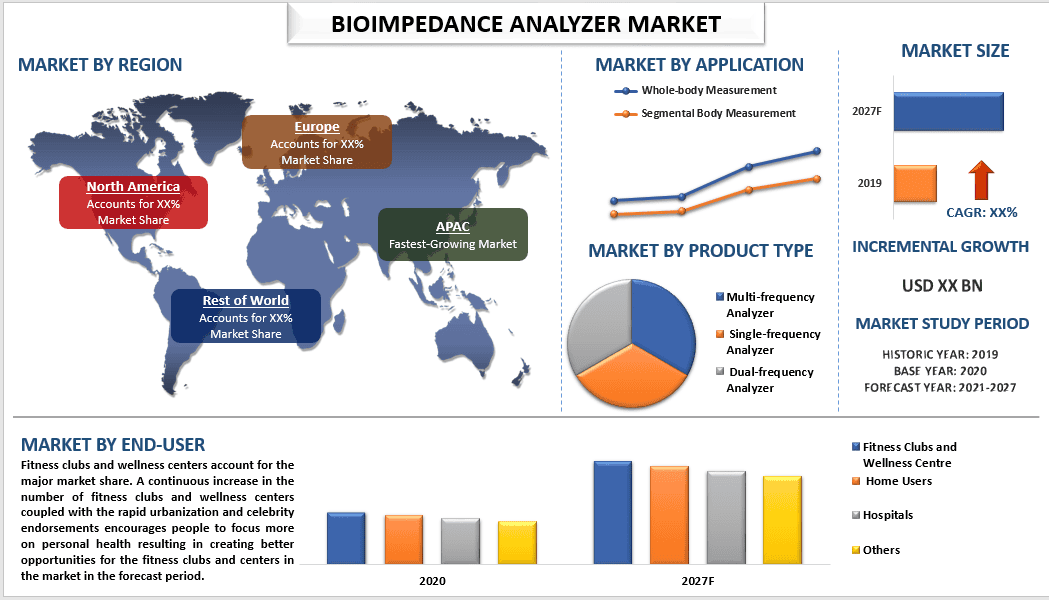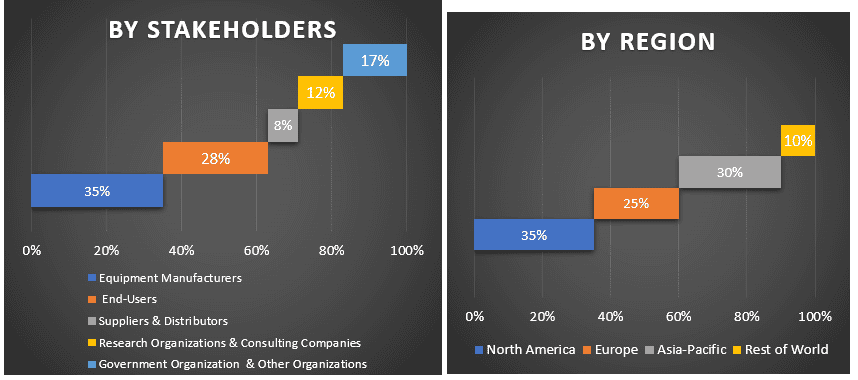- Startseite
- Über uns
- Industrie
- Dienstleistungen
- Lesen
- Kontaktieren Sie uns
Markt für Bioimpedanz-Analysegeräte: Aktuelle Analyse und Prognose (2021-2027)
Schwerpunkt auf Anwendung (Ganzkörperanalyse und segmentale Körperanalyse); Produkttyp (Multifrequenz-Analysegerät, Einfrequenz-Analysegerät und Zweifrequenz-Analysegerät); Endbenutzer (Fitnessstudios und Wellnesscenter, Privatanwender, Krankenhäuser und Sonstige); und Region/Land

KOSTENLOSE MUSTER-PDF ANFORDERN
Es wird prognostiziert, dass der Markt für Bioimpedanz-Analysegeräte zwischen 2021 und 2027 mit einer CAGR von ~9 % wachsen wird. Schlüsselfaktoren, die das Wachstum des Fitnessmarktes beeinflussen, sind die wachsende Bevölkerung auf der ganzen Welt, die Industrialisierung in den Entwicklungsländern und das gesteigerte Bewusstsein für Gesundheit und einen gesunden Lebensstil auf der ganzen Welt. Mit der zunehmenden Bevölkerung und der rasanten Urbanisierung in den meisten Ländern nehmen die mit dem Lebensstil verbundenen Krankheiten auf der ganzen Welt zu. Diese Krankheiten können zu anderen schweren Krankheiten führen. Laut CDC sind übergewichtige Menschen 36 % anfälliger für einen Herzinfarkt als Menschen mit anderen Erkrankungen. Darüber hinaus tragen zunehmende Aufklärungsprogramme über körperliche Gesundheit in Verbindung mit zunehmenden Investitionen verschiedener Institutionen in die Tier- oder Humanforschung zur Marktexpansion von Bioimpedanz-Analysegeräten bei. Darüber hinaus kann erwartet werden, dass die technologischen Fortschritte in diesem Sektor den Markt für Bioimpedanz-Analysegeräte ebenfalls vergrößern werden.
Die anhaltende COVID-19-Pandemie auf der ganzen Welt hat enorme Auswirkungen auf verschiedene Bereiche der Gesellschaft, nicht zuletzt auf den Markt für Bioimpedanz-Analysegeräte. Der Markt für Bioimpedanz-Analysegeräte war von Bewegungseinschränkungen betroffen, die die Menschen gezwungen haben, zu Hause zu bleiben, und so kam es zu einem starken Rückgang der Besuche in Krankenhäusern und Kliniken sowie in Fitnessstudios. Dies hat den Handel mit Bioimpedanz-Analysegeräten aufgrund der geringeren Nachfrage und der weit verbreiteten finanziellen Notlage beeinträchtigt.
Im Bericht dargestellte Einblicke
„Unter den Produkttypen hatten Mehrfrequenz-Bioimpedanzgeräte im Jahr 2020 einen bedeutenden Marktanteil.“
Auf der Grundlage des Produkttyps wird der Markt in Multifrequenz-, Einfrequenz- und Doppelfrequenz-Analysegeräte unterteilt. Unter diesen trugen Mehrfrequenz-Bioimpedanzgeräte, die Impedanzen bei verschiedenen Frequenzen messen können, im Jahr 2020 den größten Umsatzmarktanteil. Die bioelektrische Impedanzanalyse kann auch verwendet werden, um die appendikuläre Magermasse (BIA) zu bestimmen. Sie verbessert die Genauigkeit und Effizienz von fettfreier Masse, Gesamtkörperwasser sowie intra- und extrazellulären Wasserberechnungen. Die zunehmende Popularität und Anerkennung von Mehrfrequenz-Bioimpedanzgeräten wird das Marktwachstum während des gesamten Prognosezeitraums voraussichtlich unterstützen.
Unter den Anwendungen dominierte die Segmentmessung im Jahr 2020 den Markt.
Basierend auf der Anwendung wird der Markt in Ganzkörpermessung und segmentale Körpermessung unterteilt. Im Jahr 2020 hatte die segmentale Körpermessung aufgrund ihrer Genauigkeit einen großen Anteil am Markt. Der segmentierte Körper analysiert jeden Teil des Körpers und liefert das Ergebnis, das zur Analyse des Körpers und zur Identifizierung der Anomalie verwendet werden kann. Darüber hinaus wird die segmentale Körpermessung auch im Sport eingesetzt, um Sportler zu trainieren, indem sie die Stärke der Organe identifiziert und innere Verletzungen während des Sports erkennt. Darüber hinaus expandieren wichtige Akteure auf dem Markt mit dem wachsenden Bewusstsein für die persönliche Fitness über geografische Grenzen hinweg und bieten neue und fortschrittliche Produkte an. Beispielsweise hat Inbody im April 2022 seinen Körperwasseranalysator BWA 2.0 auf den Markt gebracht, der die Körperwasserzusammensetzung, ihre segmentale Aufschlüsselung und Schwankungen misst, um ihre langfristigen Auswirkungen auf Gesundheit und Vitalität zu bestimmen.
„Unter den Endverbrauchern dürften Fitnessstudios und Wellnesscenter im vorhersehbaren Zeitraum einen bedeutenden Marktanteil erobern.“
Basierend auf dem Endverbraucher wurde der Markt in Fitnessstudios und Wellnesscenter, Privatanwender, Krankenhäuser und andere unterteilt. Unter diesen wird erwartet, dass Fitnessstudios und Wellnesscenter in der prognostizierten Zukunft aufgrund des weltweit wachsenden Bewusstseins für Gesundheit und Fitness deutlich wachsen werden. Die Zahl der Fitnessstudios und Wellnesscenter hat sich im letzten Jahrzehnt dramatisch erhöht, was zu einer stärkeren Betonung von Gesundheit und Fitness in der Bevölkerung geführt hat, was das Wachstum des Segments stimuliert. Es wird auch erwartet, dass die Kategorie der Privatanwender in der Branche schnell wachsen wird. Die Segmentnachfrage wird durch laufende technologische Fortschritte und die zunehmende Nutzung von Bioimpedanz-Analysegeräten günstig beeinflusst. Die Verwendung eines Bioimpedanz-Analysegeräts nimmt als Mittel zur Bestimmung der Körperzusammensetzung zur Erhaltung von Gesundheit und Fitness zu. Dieses Tool kann ohne die Hilfe eines Fachmanns verwendet werden. Infolgedessen könnte es in naher Zukunft als Katalysator für die Sektornachfrage fungieren.
„Der asiatisch-pazifische Raum hält den Löwenanteil am Markt für Bioimpedanz-Analysegeräte“
Während des Prognosezeitraums wird erwartet, dass der asiatisch-pazifische Raum aufgrund der anhaltenden Industrialisierung und der wachsenden gesundheitlichen Bedenken ein erhebliches Wachstum verzeichnen wird, was die Produktionsleistung angekurbelt und den globalen Markt für Fitnessgeräte positiv beeinflusst hat. Steigende F&E-Aktivitäten zusammen mit Schwellenländern wie China und Indien tragen zur Entwicklung des Marktes in der Region bei. Darüber hinaus zieht das wachsende Bewusstsein für Gesundheitsversorgung und Fitness sowie die zunehmende Beteiligung der Öffentlichkeit an professionellen Sportarten in der Region und die steigende Zahl von Fettleibigkeitsfällen Investoren in der Region an. Darüber hinaus fördert die aktive Beteiligung von Regierung und privaten Akteuren an Gesundheits- und Fitnessaktivitäten das Wachstum lokaler Akteure im Land. Darüber hinaus macht die Präsenz der wichtigsten Marktteilnehmer in China und Japan den asiatisch-pazifischen Raum zu einer idealen Region für das Marktwachstum in der prognostizierten Zukunft. Beispielsweise sind Fook Tin Group Holding Ltd. und OMRON Corporation die wichtigsten Akteure auf dem Bioimpedanzmarkt in der APAC-Region.
SPRECHEN SIE MIT EINEM ANALYSTEN
Gründe für den Kauf dieses Berichts:
- Die Studie umfasst eine Marktdimensionierungs- und Prognoseanalyse, die von authentifizierten wichtigen Branchenexperten validiert wurde.
- Der Bericht bietet einen schnellen Überblick über die Gesamtleistung der Branche auf einen Blick.
- Der Bericht umfasst eine eingehende Analyse prominenter Branchenkollegen mit einem primären Fokus auf wichtige Finanzdaten, Produktportfolio, Expansionsstrategien und aktuelle Entwicklungen.
- Detaillierte Untersuchung der Treiber, Beschränkungen, wichtigsten Trends und Chancen in der Branche.
- Die Studie deckt den Markt umfassend über verschiedene Segmente hinweg ab.
- Tiefgehende regionale Analyse der Branche
Anpassungsoptionen:
Der Bioimpedanz-Analysegerätemarkt kann je nach Anforderung oder einem anderen Marktsegment weiter angepasst werden. Darüber hinaus versteht UMI, dass Sie möglicherweise Ihre eigenen geschäftlichen Anforderungen haben. Nehmen Sie daher gerne Kontakt mit uns auf, um einen Bericht zu erhalten, der Ihren Anforderungen vollständig entspricht.
Inhaltsverzeichnis
Forschungsmethodik für die Marktanalyse von Bioimpedanz-Analysegeräten (2021-2027)
Die Analyse des historischen Marktes, die Schätzung des aktuellen Marktes und die Prognose des zukünftigen Marktes für Bioimpedanz-Analysegeräte waren die drei wichtigsten Schritte, die unternommen wurden, um die Akzeptanz von Bioimpedanz-Analysegeräten in den wichtigsten Regionen weltweit zu erstellen und zu analysieren. Es wurden umfassende Sekundärrecherchen durchgeführt, um die historischen Marktzahlen zu erfassen und die aktuelle Marktgröße zu schätzen. Zweitens wurden zahlreiche Erkenntnisse und Annahmen berücksichtigt, um diese Erkenntnisse zu validieren. Darüber hinaus wurden ausführliche Primärinterviews mit Branchenexperten entlang der Wertschöpfungskette des Marktes für Bioimpedanz-Analysegeräte geführt. Nach der Annahme und Validierung der Marktzahlen durch Primärinterviews wendeten wir einen Top-Down/Bottom-Up-Ansatz an, um die vollständige Marktgröße zu prognostizieren. Danach wurden Methoden zur Marktaufschlüsselung und Datentriangulation angewendet, um die Marktgröße von Segmenten und Untersegmenten der Branche zu schätzen und zu analysieren. Die detaillierte Methodik wird im Folgenden erläutert:
Weitere Details zur Forschungsmethodik anfordern
Analyse der historischen Marktgröße
Schritt 1: Eingehende Untersuchung sekundärer Quellen:
Es wurde eine detaillierte Sekundärstudie durchgeführt, um die historische Marktgröße des Bioimpedanz-Analysegeräts über unternehmensinterne Quellen wie Geschäftsberichte & Finanzberichte, Performance-Präsentationen, Pressemitteilungen usw. und externe Quellen wie Fachzeitschriften, Nachrichten & Artikel, Regierungsveröffentlichungen, Wettbewerbsveröffentlichungen, Sektorberichte, Datenbanken von Drittanbietern und andere glaubwürdige Veröffentlichungen zu erhalten.
Schritt 2: Marktsegmentierung:
Nachdem wir die historische Marktgröße des Marktes für Bioimpedanz-Analysegeräte ermittelt hatten, führten wir eine detaillierte Sekundäranalyse durch, um historische Markteinblicke und Anteile für verschiedene Segmente & Untersegmente für die wichtigsten Regionen zu sammeln. Zu den wichtigsten Segmenten, die in dem Bericht enthalten sind, gehören Produkttyp, Anwendung und Endverbraucher. Weitere Analysen auf Länderebene wurden durchgeführt, um die Gesamtakzeptanz von Bioimpedanz-Analysegeräten in dieser Region zu bewerten.
Schritt 3: Faktorenanalyse:
Nachdem wir die historische Marktgröße verschiedener Segmente und Untersegmente ermittelt hatten, führten wir eine detaillierte Faktorenanalyse durch, um die aktuelle Marktgröße des Marktes für Bioimpedanz-Analysegeräte zu schätzen. Darüber hinaus führten wir eine Faktorenanalyse unter Verwendung von abhängigen und unabhängigen Variablen durch, wie z. B. die zunehmende Digitalisierung der Industrie und die Urbanisierung in Entwicklungsländern. Es wurde eine gründliche Analyse der Nachfrage- und Angebotsseitenszenarien unter Berücksichtigung von Top-Partnerschaften, Fusionen und Übernahmen, Geschäftsausweitungen und Produkteinführungen im Bereich der Bioimpedanz-Analysegeräte weltweit durchgeführt.
Schätzung & Prognose der aktuellen Marktgröße
Aktuelle Marktgröße: Basierend auf den umsetzbaren Erkenntnissen aus den oben genannten 3 Schritten ermittelten wir die aktuelle Marktgröße, die wichtigsten Akteure auf dem Markt für Bioimpedanz-Analysegeräte und die Marktanteile der Segmente. Alle erforderlichen prozentualen Anteile und Marktaufschlüsselungen wurden anhand des oben genannten sekundären Ansatzes ermittelt und durch Primärinterviews verifiziert.
Schätzung & Prognose: Für die Marktschätzung und -prognose wurden verschiedenen Faktoren, einschließlich Triebkräften & Trends, Beschränkungen und Möglichkeiten, die den Interessengruppen zur Verfügung stehen, Gewichte zugewiesen. Nach der Analyse dieser Faktoren wurden relevante Prognosetechniken, d. h. der Top-Down/Bottom-Up-Ansatz, angewendet, um die Marktprognose für 2027 für verschiedene Segmente und Untersegmente in den wichtigsten Märkten weltweit zu erstellen. Die Forschungsmethodik, die zur Schätzung der Marktgröße angewendet wurde, umfasst:
- Die Marktgröße der Branche, in Bezug auf den Wert (US$) und die Akzeptanzrate von Bioimpedanz-Analysegeräten in den wichtigsten Märkten im Inland
- Alle prozentualen Anteile, Aufteilungen und Aufschlüsselungen von Marktsegmenten und -untersegmenten
- Die wichtigsten Akteure auf dem Markt für Bioimpedanz-Analysegeräte in Bezug auf die angebotenen Produkte. Außerdem die Wachstumsstrategien, die diese Akteure anwenden, um in dem schnell wachsenden Markt wettbewerbsfähig zu sein
Validierung der Marktgröße und der Marktanteile
Primärforschung: Es wurden ausführliche Interviews mit den wichtigsten Meinungsbildnern (Key Opinion Leaders, KOLs) geführt, darunter Top-Level-Führungskräfte (CXO/VPs, Vertriebsleiter, Marketingleiter, Betriebsleiter, Regionalleiter, Länderleiter usw.) in den wichtigsten Regionen. Die Ergebnisse der Primärforschung wurden dann zusammengefasst und eine statistische Analyse durchgeführt, um die aufgestellte Hypothese zu beweisen. Die Erkenntnisse aus der Primärforschung wurden mit den Ergebnissen der Sekundärforschung zusammengeführt, wodurch Informationen in umsetzbare Erkenntnisse umgewandelt wurden.
Aufteilung der primären Teilnehmer in verschiedene Regionen

Markt-Engineering
Es wurde eine Datentriangulationstechnik angewendet, um die Gesamtmarktschätzung abzuschließen und genaue statistische Zahlen für jedes Segment und Untersegment des Marktes für Bioimpedanz-Analysegeräte zu erhalten. Die Daten wurden in verschiedene Segmente & Untersegmente aufgeteilt, nachdem verschiedene Parameter und Trends in den Bereichen Produkttyp und Endverbraucher des Marktes für Bioimpedanz-Analysegeräte untersucht wurden.
Das Hauptziel der Marktstudie für Bioimpedanz-Analysegeräte
Die aktuellen & zukünftigen Markttrends von Bioimpedanz-Analysegeräten wurden in der Studie aufgezeigt. Investoren können strategische Einblicke gewinnen, um ihre Entscheidung für Investitionen auf der Grundlage der in der Studie durchgeführten qualitativen und quantitativen Analyse zu treffen. Aktuelle und zukünftige Markttrends bestimmten die Gesamtattraktivität des Marktes auf regionaler Ebene und boten den Industrieteilnehmern eine Plattform, um den unerschlossenen Markt zu nutzen und vom First-Mover-Vorteil zu profitieren. Weitere quantitative Ziele der Studien sind:
- Analyse der aktuellen und prognostizierten Marktgröße von Bioimpedanz-Analysegeräten in Bezug auf den Wert (US$). Außerdem Analyse der aktuellen und prognostizierten Marktgröße verschiedener Segmente und Untersegmente
- Die Segmente in der Studie umfassen Anwendungsbereiche, Produkttyp, Endverbraucher und Region.
- Definition und Analyse des regulatorischen Rahmens für die Bioimpedanz-Analysegeräteindustrie
- Analyse der Wertschöpfungskette unter Beteiligung verschiedener Intermediäre sowie Analyse des Kunden- und Wettbewerbsverhaltens der Branche
- Analyse der aktuellen und prognostizierten Marktgröße des Marktes für Bioimpedanz-Analysegeräte für die wichtigsten Regionen
- Zu den wichtigsten Regionen, die in dem Bericht untersucht werden, gehören Nordamerika (USA, Kanada und das übrige Nordamerika), Europa (Deutschland, Vereinigtes Königreich, Frankreich, Spanien, Italien und das übrige Europa), der asiatisch-pazifische Raum (China, Japan, Indien, Australien und andere) und der Rest der Welt
- Unternehmensprofile des Marktes für Bioimpedanz-Analysegeräte und die Wachstumsstrategien, die von den Marktteilnehmern angewendet werden, um sich in dem schnell wachsenden Markt zu behaupten
- Tiefgehende regionale Analyse der Branche
Verwandt Berichte
Kunden, die diesen Artikel gekauft haben, kauften auch










